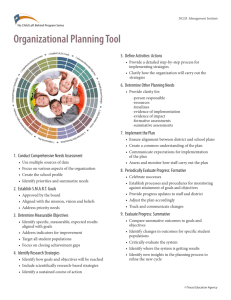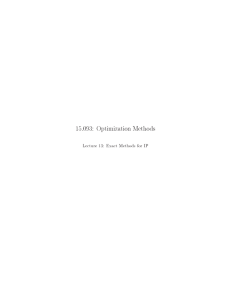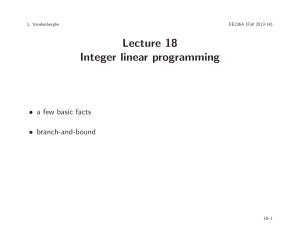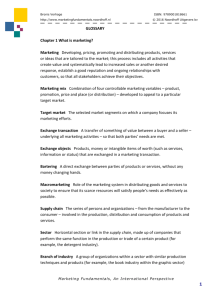15.081J/6.251J Introduction to Mathematical Programming Lecture 25: Exact Methods
advertisement
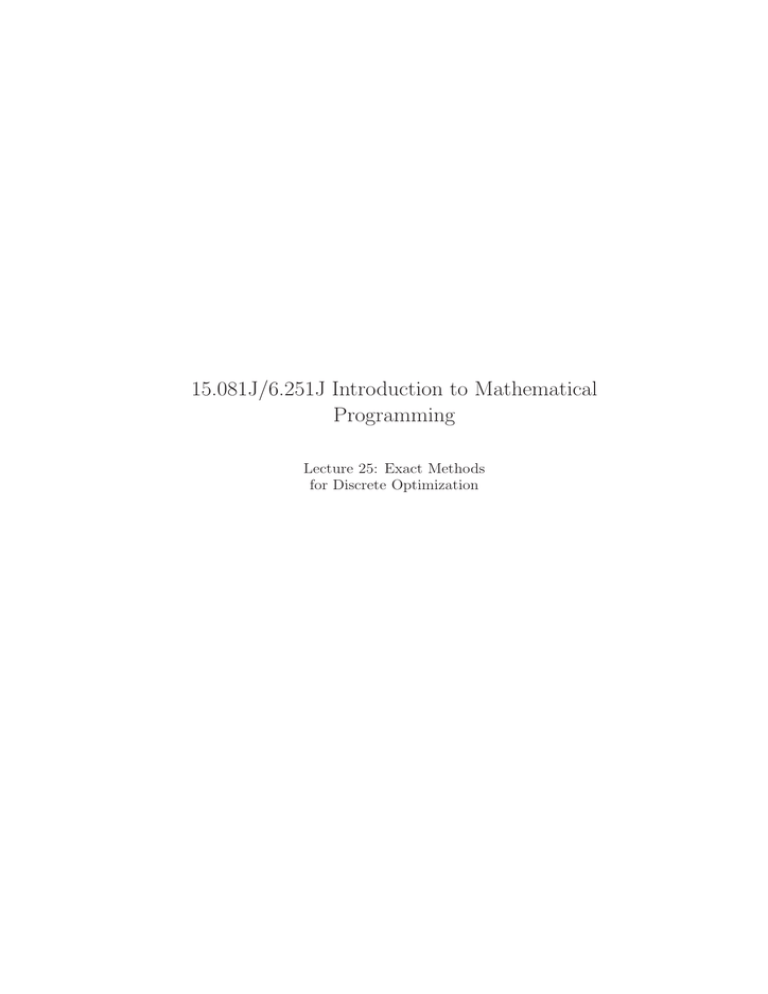
15.081J/6.251J Introduction to Mathematical
Programming
Lecture 25: Exact Methods
for Discrete Optimization
1
Outline
Slide 1
• Cutting plane methods
• Branch and bound methods
2
Cutting plane methods
Slide 2
min c′ x
s.t. Ax = b
x ≥ 0
x integer,
LP relaxation
min c′ x
s.t. Ax = b
x ≥ 0.
2.1 Algorithm
Slide 3
• Solve the LP relaxation. Let x∗ be an optimal solution.
• If x∗ is integer stop; x∗ is an optimal solution to IP.
• If not, add a linear inequality constraint to LP relaxation that all integer
solutions satisfy, but x∗ does not; go to Step 1.
2.2 Example
Slide 4
• Let x∗ be an optimal BFS to LP ralxation with at least one fractional
basic variable.
• N : set of indices of the nonbasic variables.
• Is this a valid cut?
�
xj ≥ 1.
j∈N
2.3 The Gomory cutting
plane algorithm
Slide 5
• Let x∗ be an optimal BFS and B an optimal basis.
•
�
�
• aij = B −1 Aj i , ai0
xB + B −1 AN xN = B −1 b.
�
�
= B −1 b i .
1
•
xi +
�
aij xj = ai0 .
j∈N
• Since xj ≥ 0 for all j,
xi +
�
⌊aij ⌋xj ≤ xi +
j∈N
�
aij xj = ai0 .
j∈N
• Since xj integer,
xi +
�
⌊aij ⌋xj ≤ ⌊ai0 ⌋.
j∈N
• Valid cut
2.4
Example
Slide 6
min
x1 −
s.t. −4x1 +
x1 +
x1 , x2
x1 , x2
2x2
6x2 ≤ 9
x2 ≤ 4
≥0
integer.
We transform the problem in standard form
min
x1 − 2x2
s.t. −4x1 + 6x2 + x3
= 9
x1 + x2
+ x4 = 4
x1 , . . . , x4 ≥ 0
x1 , . . . , x4 integer.
LP relaxation: x1 = (15/10, 25/10).
•
x2 +
Slide 7
1
1
25
x3 + x4 =
.
10
10
10
• Gomory cut
x2 ≤ 2.
• Add constraints x2 + x5 = 2, x5 ≥ 0
• New optimal x2 = (3/4, 2).
• One of the equations in the optimal tableau is
1
6
3
x1 − x3 + x5 = .
4
4
4
• New Gomory cut
x1 − x3 + x5 ≤ 0,
• New optimal solution is x3 = (1, 2).
2
Slide 8
x2
3
.
x1
2
..
- 3 x 1 + 5x2 < 7
x2
x3
x2 < 2
1
0
3
1
2
3
4
x1
Branch and bound
Slide 9
1. Branching: Select an active subproblem Fi
2. Pruning: If the subproblem is infeasible, delete it.
3. Bounding: Otherwise, compute a lower bound b(Fi ) for the subproblem.
4. Pruning: If b(Fi ) ≥ U , the current best upperbound, delete the subproblem.
5. Partitioning: If b(Fi ) < U , either obtain an optimal solution to the subproblem
(stop), or break the corresponding problem into further subproblems, which are
added to the list of active subproblem.
3.1
LP Based
Slide 10
• Compute the lower bound b(F ) by solving the LP relaxation of the discrete
optimization problem.
• From the LP solution x∗ , if there is a component x∗i which is fractional,
we create two subproblems by adding either one of the constraints
xi ≤ ⌊x∗i ⌋, or xi ≥ ⌈xi∗ ⌉.
Note that both constraints are violated by x∗ .
• If there are more than 2 fractional components, we use selection rules like
maximum infeasibility etc. to determine the inequalities to be added to
the problem
• Select the active subproblem using either depth-first or breadth-first search
strategies.
3.2
Example
Slide 11
max 12x1 + 8x2 + 7x3 + 6x4
s.t. 8x1 + 6x2 + 5x3 + 4x4 ≤ 15
x1 , x2 , x3 , x4 are binary.
3
Ob j e ctiv e v a l u e
=22.2
x1=1, x 2=0, x 3=0 . 6 , x
4=1
x3=1
x3=0
Ob j e ctiv e v a l u e
Ob j e ctiv e v a l u e
=22
x1=1, x 2=0.5,x
3=0 , x
x1=1, x 2=0, x 3=1 x, 4=0 . 5
4=1
Ob j e ctiv e v a l u e
=22.2
x1=1, x 2=0, x 3=0 . 6 , x
4=1
x3=1
x3=0
Ob j e ctiv e v a l u e
x1=1, x 2=0.5,x
=22
Ob j e ctiv e v a l u e
=22
3=0 , x
=22
x1=1, x 2=0, x 3=1, x 4=0 . 5
4=1
x4=1
x4=0
Ob j e ctiv e v a l u e
x1=1, x 2=0 . 3 , x
=2 1 . 6 6
Ob j e ctiv e v a l u e
3=1 , x 4=0
x1=0 . 7 5 , x
=22
2=0 , x 3=1 , x 4=1
LP relaxation
Slide 12
max 12x1 + 8x2 + 7x3 + 6x4
s.t.
8x1 + 6x2 + 5x3 + 4x4 ≤ 15
x1 ≤ 1, x2 ≤ 1, x3 ≤ 1, x4 ≤ 1
x1 , x2 , x3 , x4 ≥ 0
LP solution: x1 = 1, x2 = 0, x3 = 0.6, x4 = 1 Profit=22.2
3.2.1
Branch and bound tree
3.3 Pigeonhole Problem
• There are n + 1 pigeons with n holes. We want to place the pigeons in the
holes in such a way that no two pigeons go into the same hole.
Slide
Slide
Slide
Slide
13
14
15
16
• Let xij = 1 if pigeon i goes into hole j, 0 otherwise.
Slide 17
• Formulation 1:
�
j
xij = 1, i = 1, . . . , n + 1
xij + xkj ≤ 1, ∀j, i =
� k
4
Ob j e ctiv e v a l u e
=22.2
x1=1, x 2=0, x 3=0 . 6 , x
4=1
x3=1
x3=0
Ob j e ctiv e v a l u e
x1=1, x 2=0.5,x
Ob j e ctiv e v a l u e
=22
3=0 , x
=22
x1=1, x 2=0, x 3=1, x 4=0 . 5
4=1
x4=1
x4=0
Ob j e ctiv e v a l u e
x1=1, x 2=0 . 3 , x
=2 1 . 6 6
3=1 , x
Ob j e ctiv e v a l u e
x1=0 . 7 5 , x
4=0
=22
2=0 , x
3=1 , x
x1=1
x1=0
Ob j e ctiv e v a l u e
4=1
=2 1
I n feasib l e
x1=0 x, 2=1 x, 3=1 x, 4=1
• Formulation 2:
�
j
xij = 1, i = 1, . . . , n + 1
�n+1
i=1
xij ≤ 1, ∀j
Which formulation is better for the problem?
Slide 18
• The pigeonhole problem is infeasible.
• For Formulation 1, feasible solution xij = n1 for all i, j. O(n3 ) constraints.
Nearly complete enumeration is needed for LP-based BB, since the prob­
lem remains feasible after fixing many variables.
• Formulation 2 Infeasible. O(n) constraints.
• Mesage: Formulation of the problem is important!
3.4
Preprocessing
Slide 19
• An effective way of improving integer programming formulations prior to and
during branch-and-bound.
• Logical Tests
– Removal of empty (all zeros) rows and columns;
– Removal of rows dominated by multiples of other rows;
– strengthening the bounds within rows by comparing individual variables
and coefficients to the right-hand-side.
– Additional strengthening may be possible for integral variables using round­
ing.
• Probing : Setting temporarily a 0-1 variable to 0 or 1 and redo the logical
tests. Force logical connection between variables. For example, if 5x + 4y + z ≤
8, x, y, z ∈ {0, 1}, then by setting x = 1, we obtain y = 0. This leads to an
inequality x + y ≤ 1.
5
1
3
4
4
5
2
6
7
Application
4.1
4.1.1
Directed TSP
Assignment Lower Bound
Slide 20
Given a directed graph G = (N, A) with n nodes, and a cost cij for every arc,
find a tour (a directed cycle that visits all nodes) of minimum cost.
�n �n
min
s.t. :
c x
j=1 ij ij
i=1
�n
xij = 1, j = 1, . . . , n,
�i=1
n
j=1
xij = 1, i = 1, ..., n,
xij ∈ {0, 1}.
Slide 21
4.2
Improving BB
Slide 22
• Better LP solver
• Use problem structure to derive better branching strategy
• Better choice of lower bound b(F ) - better relaxation
• Better choice of upper bound U - heuristic to get good solution
• KEY: Start pruning the search tree as early as possible
6
MIT OpenCourseWare
http://ocw.mit.edu
6.251J / 15.081J Introduction to Mathematical Programming
Fall 2009
For information about citing these materials or our Terms of Use, visit: http://ocw.mit.edu/terms.
